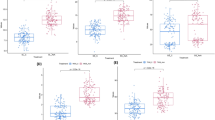Abstract
Using an isogenic line of rice having lazy gene (la), we studied the correlation between the agravitropic response at the young seedling stage and the lazy habit (prostrate growth of tillers) at the more advanced stage of growth. In this study, it was found that both agravitropism and lazy habit were controlled by the single recessivela gene. That is, F2 segregants of Kamenoo×lazy-Kamenoo, which had an agravitropic response at their young seedling stage, showed a lazy habit of growth in the more advanced stage of vegetative growth. On the other hand, seedlings that showed normal gravitropic curvature at their early stage of growth had an upright growth in the mature stage.
Similar content being viewed by others
References
Abe, K. andSuge, H. 1993. Role of gravitropic response in the dry matter production of rice (Oryza sativa L.): an experiment with a line having lazy gene. J. Plant Res.106: 337–343.
Abe, K., Takahashi, H., Hatakeda, K. andSuge, H. 1994a. Gravitropic curvature and auxin content in lazy-Kamenoo rice. Biol. Sci. Space8: 160–161 (in Japanese).
Abe, K., Takahashi, H. andSuge, H. 1994b. Graviresponding sites in shoots of normal and ‘lazy’ rice seedlings. Physiol. Plant.92: 371–374.
Abe, K., Takahashi, H. andSuge, H. 1994c. Localization of cells containing sedimented amyloplasts in the shoots of normal and lazy rice. Biol. Sci. Space8: 221–225.
Goto, I. 1978. Genetic studies on resistance of rice plant to blast fungus III. Decline in the blast resistance in Ginga, a descendant variety of Sensho. Ann. Phytopath. Soc. Japan44: 447–455.
Jones, J.W. andAdair, C.R. 1938. A “lazy” mutation in rice. J. Heredity29: 315–318.
Kaufman, P.B., Brock, T.G., Song, I., Rho, Y.B. andGhoshen, N.S. 1987. How cereal grass shoots percejve and respond to gravity. Amer. J. Bot.74: 1446–1457.
Kinoshita, T., Takahashi, M., Mori, K. andShinbashi, N. 1974. Character expression and inheritance mode of three kinds of dwarf rice. Genetic studies on rice plant, LXI. Rep. Exp. Farm Facult. Agric. Hokkaido Univ.19: 1–12.
Kutschera, U., Siebert, C., Masuda, Y. andSievers, A. 1990. Effect of submergence on development and gravitropism in the coleoptile ofOryza sativa L. Planta183: 112–119.
Morinaga, T. andFukushima, E. 1942. Heritable characters in rice I. Abnormal mutant characters and their mode of inheritance. Bult. Sci. Facult. Ter., Kyushu Imp. Univ.10: 301–309.
Nagao, S. andTakahashi, M. 1963. Trial construction of twelve linkage groups in Japanese rice. J. Facult. Agric. Hokkaido Univ. 53, Pt1: 72–130.
Sack, F.D. 1991. Plant gravity sensing. Int. Rev. Cytol.127: 193–252.
Sato, K. 1961. Studies on starch contained in the tissues of rice plant. VII.Comparative studies of starch content in several cereal crops. Proc. Crop Sci. Soc. Japan30: 34–37.
Song, I., Lu, R.C., Brock, T.G. andKaufman, P.B. 1988. Do starch statoliths act as gravisensors in cereal grass pulvini? Plant Physiol.86: 1155–1162.
Suge, H. andTürkan, Î. 1991. Can plants normally produce seeds under microgravity in space? Jpn. J. Crop Sci.60: 427–433.
Takahashi, K., Otake, H. andHoshikawa, K. 1992. Changes in the negative gravitropic response of main shoots in relation to growth stage in rice. Jpn. J. Crop Sci.61: 623–628.
Takahashi, M., Kinoshita, T. andTakeda, K. 1968. Character expressions and casual genes of some mutants in rice plant. Genetical studies on rice plant, XXXIII. J. Facult. Agric. Hokkaido Univ.55: 496–512.
van Overbeek, J. 1936. “Lazy”, an a-geotropic form of maize. “Gravitational Indifference” rather than structural weakness accounts for prostrate growth-habit of this form. J. Heredity27: 93–96.
Yamazaki, Y. 1985. Lazy-rice gotten up with tryptophan. Bot. Mag. Tokyo98: 193–198.
Author information
Authors and Affiliations
Corresponding author
Rights and permissions
About this article
Cite this article
Abe, K., Takahashi, H. & Suge, H. Lazy gene (la) responsible for both an agravitropism of seedlings and lazy habit of tiller growth in rice (Oryza sativa L.). J. Plant Res. 109, 381–386 (1996). https://doi.org/10.1007/BF02344553
Received:
Accepted:
Issue Date:
DOI: https://doi.org/10.1007/BF02344553




